Bormes Les Mimosas and Le Lavendou
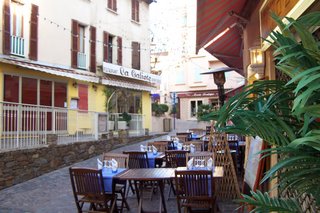
14-28 January 2007
Bormes les Mimosas as a town name is somewhat like - Abbotsford the Daffodils. But then many town and village names in France seem odd at first glance; some being highly descriptive of location or features, others being simply obscure. The mimosas are brilliant yellow blooms appearing from mid-January to early February along the Mediterranean coast. Each year Marie-Claire’s mother used to import for her flower shop in Brussels – “les mimosas de Nice”. Here they grow in the wild on the borme (hill) and in cultivation.
Bormes les Mimosas originally consisted of a medieval hillside town and today includes not only that amazingly picturesque center but also a considerable territory fronting the Mediterranean.
It abuts Le Lavandou, originally a fishing town and today expanded to include several other small towns along the coast to the east of Bormes les Mimosas. Some have suggested that the town’s name comes from “le lavande” or lavender which can grow wild in this area. But at the time of the town’s formal creation in the 15th century, the language spoken here was Provençal and in that language lavender is “queirélé”. It is more likely that the name comes from the use of a synonym of “lavoir” the place where one washes or beats the laundry and some early drawings show such places with fishermen’s wives at work.
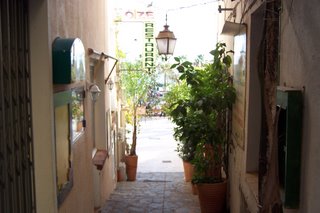

In more modern times Le Lavendou figured in some interesting sidebars to WW II. On 6 November 1942 Général Giraud was smuggled onto a British submarine by fisherman of the area. From there he was transported to Gibraltar where he joined other elements of the Free French Forces for transport to North Africa. October 1943 the Gestapo and the German Army hit the Maquis, the French Resistance, in Le Lavandou deporting many of them to camps while others were shot. Over the night of 14-15 August 1944 les Commandos d’Afrique scaled the cliffs at Cap Nègre, aided and guided by the local resistance. They were soon followed by landings of French troops and allies on the beaches here.
Beside the list of Le Lavendou’s citizens who died in the army or in the Résistance, is a copy of
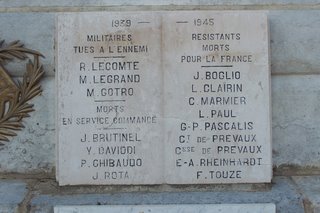 De Gaulle’s 1940 call to arms.
De Gaulle’s 1940 call to arms.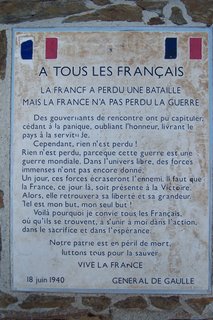
"TO ALL FRENCH PEOPLE
FRANCE HAS LOST A BATTLE BUT FRANCE HAS NOT LOST THE WAR
Some collaborating governments have capitulated, giving in to panic, forgetting honour, delivering the nation into subjection.
However, nothing is lost.
Nothing is lost, because this war is a world war. In the free world, some immense forces gave not yet begun to contribute [to the war effort].
One day these forces will crush the enemy. It is imperative that France, on that day, is present at the Victory. Then she will rediscover her liberty and her greatness. This is my goal, my only goal.
This is why I call on all Frenchmen, wherever they may be, to unite with me in action, in sacrifice and in hope.
Our nation is facing death.
Let us fight to save her.
LONG LIVE FRANCE."
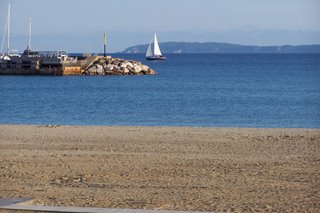 Today the beaches are, of course, used for more pleasurable activities. Both towns are significant summer resorts. As a local was just explaining, the area was inhabited by shepherds on the hills, farmers raising lavender somewhat lower down, and fishermen on the coast. But today tourism is the dominant economic driver.
Today the beaches are, of course, used for more pleasurable activities. Both towns are significant summer resorts. As a local was just explaining, the area was inhabited by shepherds on the hills, farmers raising lavender somewhat lower down, and fishermen on the coast. But today tourism is the dominant economic driver.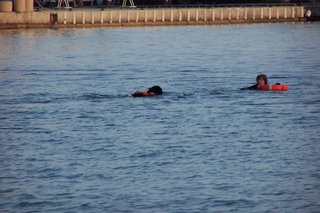
The beaches are also used for a rather unique activity – training rescue dogs – black St. Bernards.
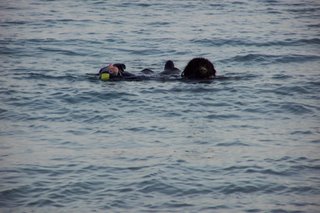
The handler points to a person floundering in the water while pointing and shouting “là bas, là bas” – over there, over there. The dog reaches the person and tows him/her to shore.

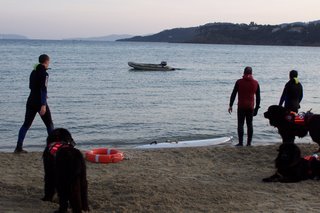
For more variety and challenge, the swimmers hide behind the dinghy. The usual cries of “là bas, là bas” are followed when the dog reaches the dinghy by “fais le tour, fais le tour” – make the tour – or swim around the dinghy. The dog does just that and emerges from the other side with swimmer in tow.
For a long time the towns have attracted artists – particularly to Saint-Clair, technically part of Le Lavendou. Two neo-impressionists, Théo Van Rysselberghe ( a Belgian) and Henri-Edmond Cross, lived here in the late 19th and early 20th centuries and attracted other artists. Their work is displayed in the area and the sites of many of their paintings identified.

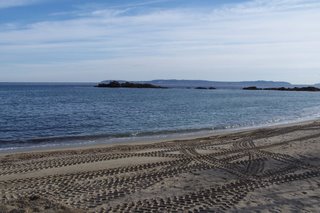
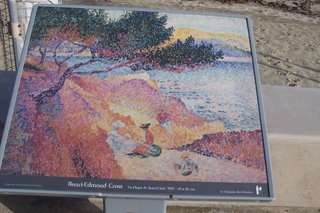
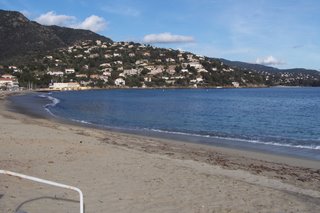
Art still flourishes here with the work of many local artists readily available. While working in an Internet outlet here, Roger met a mother and daughter with a gallery in Berkley California, Giorgi Gallery. They have launched a small art school here ($1000/week including food and lodging, local travel, fresco painting lessons etc.), all in Saint-Clair, a beautiful location for painting or simply a restful vacation.
 Both towns have extensive bike and pedestrian trails inland and extensive hiking trails along the sometimes precipitous coast, like this very well constructed and maintained pedestrian trail leading from Le Lavendou to Saint Clair.
Both towns have extensive bike and pedestrian trails inland and extensive hiking trails along the sometimes precipitous coast, like this very well constructed and maintained pedestrian trail leading from Le Lavendou to Saint Clair.Or this more rugged one from Bormes westward about 18 km.
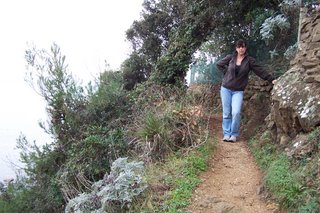

On this trail we found lots of marble embedded in the rock and washed up on the beaches. See Aydin, just like Grampa told you.
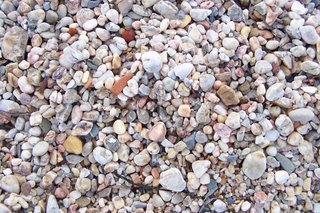

A bike trail parallels the coast through the 6 communities and 12 beaches of Le Lavendou while another climbs and climbs to the heights of the medieval village of Bormes.
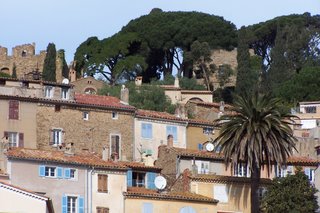 With narrow winding streets and alleys, excellent restaurants and medieval homes, chapels and a castle, Bormes makes a very interesting afternoon. Summer would of course see more blooms - but also more, many more tourists.
With narrow winding streets and alleys, excellent restaurants and medieval homes, chapels and a castle, Bormes makes a very interesting afternoon. Summer would of course see more blooms - but also more, many more tourists.




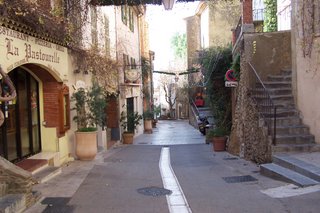
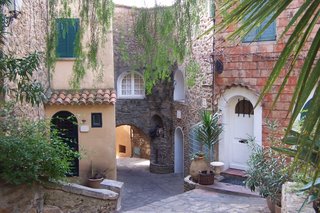
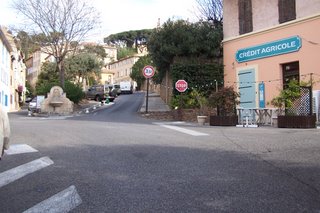 We couldn't resist including this one on the way up to Bormes. Who is supposed to stop? Enlarge the picture by left clicking on it and answer this quiz. Only North Americans qualify for the prize, since te answer would be second nature to all Europeans. It is rare to see a Stop sign that is square to the cars it is intended to stop. Invariably they are at an angle. Often tey are such an angle that one wonders when approaching an intersection - who stops? In this case cars on the street to the right have to stop. Imagine computing this at 90 km/hour while travelling on a main route in the country and spotting a sign like this. Ah the joys of drivng in Europe.
We couldn't resist including this one on the way up to Bormes. Who is supposed to stop? Enlarge the picture by left clicking on it and answer this quiz. Only North Americans qualify for the prize, since te answer would be second nature to all Europeans. It is rare to see a Stop sign that is square to the cars it is intended to stop. Invariably they are at an angle. Often tey are such an angle that one wonders when approaching an intersection - who stops? In this case cars on the street to the right have to stop. Imagine computing this at 90 km/hour while travelling on a main route in the country and spotting a sign like this. Ah the joys of drivng in Europe.La Chapelle Saint François de Paule was built in 1560 to honour the person who delivered the village from the plague in 1481.

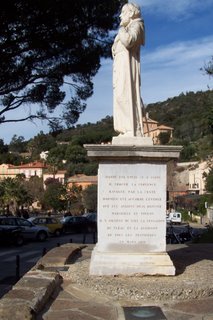
Left click to enlarge the statue and read the inscription in French. Basically it explains that
having been sent by Louis XI to Provence when it was being ravaged by the plague, he was refused entry to Marseilles and Toulon but welcomed by Bormes where “in 1481 he obtained from heaven the end of the plague and the cure of all those afflicted”.
 Another characteristic of the Mediterranean coast of France is the tens of thousands locked up, boarded up homes and especially apartments that are used only in the summer months. In this sense it is kind of like the Georgian Bay of Ontario, the Laurentides of Québec or the Gulf Islands of British Columbia – at least how they were until the 1970’s when they increasingly became year-round residences. In this area there are thousands of permanent residents. But their ranks are tripled or quadrupled during the summer. It is an interesting phenomenon when there are thousands of homeless people.
Another characteristic of the Mediterranean coast of France is the tens of thousands locked up, boarded up homes and especially apartments that are used only in the summer months. In this sense it is kind of like the Georgian Bay of Ontario, the Laurentides of Québec or the Gulf Islands of British Columbia – at least how they were until the 1970’s when they increasingly became year-round residences. In this area there are thousands of permanent residents. But their ranks are tripled or quadrupled during the summer. It is an interesting phenomenon when there are thousands of homeless people.This apartment building in Le Lavandou is about 50% occupied, actually a very high occupancy level compared to many.
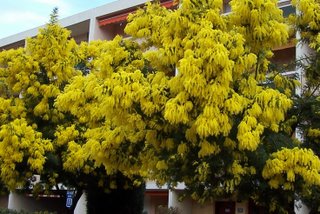
The reason for part of Bormes’ name – les mimosas.


<< Home